Sihan Yang
GRAN-TED: Generating Robust, Aligned, and Nuanced Text Embedding for Diffusion Models
Dec 17, 2025Abstract:The text encoder is a critical component of text-to-image and text-to-video diffusion models, fundamentally determining the semantic fidelity of the generated content. However, its development has been hindered by two major challenges: the lack of an efficient evaluation framework that reliably predicts downstream generation performance, and the difficulty of effectively adapting pretrained language models for visual synthesis. To address these issues, we introduce GRAN-TED, a paradigm to Generate Robust, Aligned, and Nuanced Text Embeddings for Diffusion models. Our contribution is twofold. First, we propose TED-6K, a novel text-only benchmark that enables efficient and robust assessment of an encoder's representational quality without requiring costly end-to-end model training. We demonstrate that performance on TED-6K, standardized via a lightweight, unified adapter, strongly correlates with an encoder's effectiveness in downstream generation tasks. Second, guided by this validated framework, we develop a superior text encoder using a novel two-stage training paradigm. This process involves an initial fine-tuning stage on a Multimodal Large Language Model for better visual representation, followed by a layer-wise weighting method to extract more nuanced and potent text features. Our experiments show that the resulting GRAN-TED encoder not only achieves state-of-the-art performance on TED-6K but also leads to demonstrable performance gains in text-to-image and text-to-video generation. Our code is available at the following link: https://anonymous.4open.science/r/GRAN-TED-4FCC/.
MMSI-Video-Bench: A Holistic Benchmark for Video-Based Spatial Intelligence
Dec 11, 2025Abstract:Spatial understanding over continuous visual input is crucial for MLLMs to evolve into general-purpose assistants in physical environments. Yet there is still no comprehensive benchmark that holistically assesses the progress toward this goal. In this work, we introduce MMSI-Video-Bench, a fully human-annotated benchmark for video-based spatial intelligence in MLLMs. It operationalizes a four-level framework, Perception, Planning, Prediction, and Cross-Video Reasoning, through 1,106 questions grounded in 1,278 clips from 25 datasets and in-house videos. Each item is carefully designed and reviewed by 3DV experts with explanatory rationales to ensure precise, unambiguous grounding. Leveraging its diverse data sources and holistic task coverage, MMSI-Video-Bench also supports three domain-oriented sub-benchmarks (Indoor Scene Perception Bench, Robot Bench and Grounding Bench) for targeted capability assessment. We evaluate 25 strong open-source and proprietary MLLMs, revealing a striking human--AI gap: many models perform near chance, and the best reasoning model lags humans by nearly 60%. We further find that spatially fine-tuned models still fail to generalize effectively on our benchmark. Fine-grained error analysis exposes systematic failures in geometric reasoning, motion grounding, long-horizon prediction, and cross-video correspondence. We also show that typical frame-sampling strategies transfer poorly to our reasoning-intensive benchmark, and that neither 3D spatial cues nor chain-of-thought prompting yields meaningful gains. We expect our benchmark to establish a solid testbed for advancing video-based spatial intelligence.
The Unseen Bias: How Norm Discrepancy in Pre-Norm MLLMs Leads to Visual Information Loss
Dec 09, 2025Abstract:Multimodal Large Language Models (MLLMs), which couple pre-trained vision encoders and language models, have shown remarkable capabilities. However, their reliance on the ubiquitous Pre-Norm architecture introduces a subtle yet critical flaw: a severe norm disparity between the high-norm visual tokens and the low-norm text tokens. In this work, we present a formal theoretical analysis demonstrating that this imbalance is not a static issue. Instead, it induces an ``asymmetric update dynamic,'' where high-norm visual tokens exhibit a ``representational inertia,'' causing them to transform semantically much slower than their textual counterparts. This fundamentally impairs effective cross-modal feature fusion. Our empirical validation across a range of mainstream MLLMs confirms that this theoretical dynamic -- the persistence of norm disparity and the resulting asymmetric update rates -- is a prevalent phenomenon. Based on this insight, we propose a remarkably simple yet effective solution: inserting a single, carefully initialized LayerNorm layer after the visual projector to enforce norm alignment. Experiments conducted on the LLaVA-1.5 architecture show that this intervention yields significant performance gains not only on a wide suite of multimodal benchmarks but also, notably, on text-only evaluations such as MMLU, suggesting that resolving the architectural imbalance leads to a more holistically capable model.
Improving Alignment in LVLMs with Debiased Self-Judgment
Aug 28, 2025



Abstract:The rapid advancements in Large Language Models (LLMs) and Large Visual-Language Models (LVLMs) have opened up new opportunities for integrating visual and linguistic modalities. However, effectively aligning these modalities remains challenging, often leading to hallucinations--where generated outputs are not grounded in the visual input--and raising safety concerns across various domains. Existing alignment methods, such as instruction tuning and preference tuning, often rely on external datasets, human annotations, or complex post-processing, which limit scalability and increase costs. To address these challenges, we propose a novel approach that generates the debiased self-judgment score, a self-evaluation metric created internally by the model without relying on external resources. This enables the model to autonomously improve alignment. Our method enhances both decoding strategies and preference tuning processes, resulting in reduced hallucinations, enhanced safety, and improved overall capability. Empirical results show that our approach significantly outperforms traditional methods, offering a more effective solution for aligning LVLMs.
Small-Large Collaboration: Training-efficient Concept Personalization for Large VLM using a Meta Personalized Small VLM
Aug 10, 2025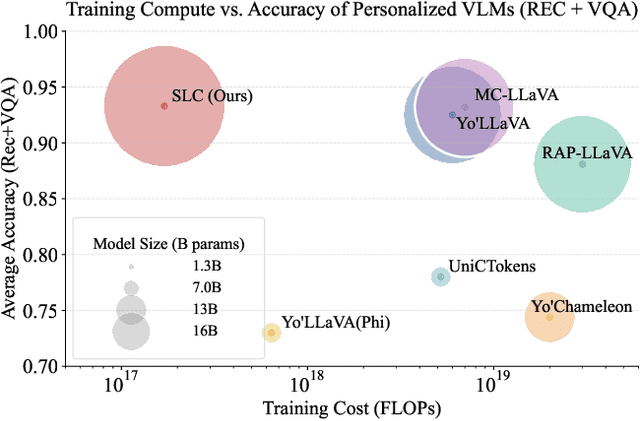

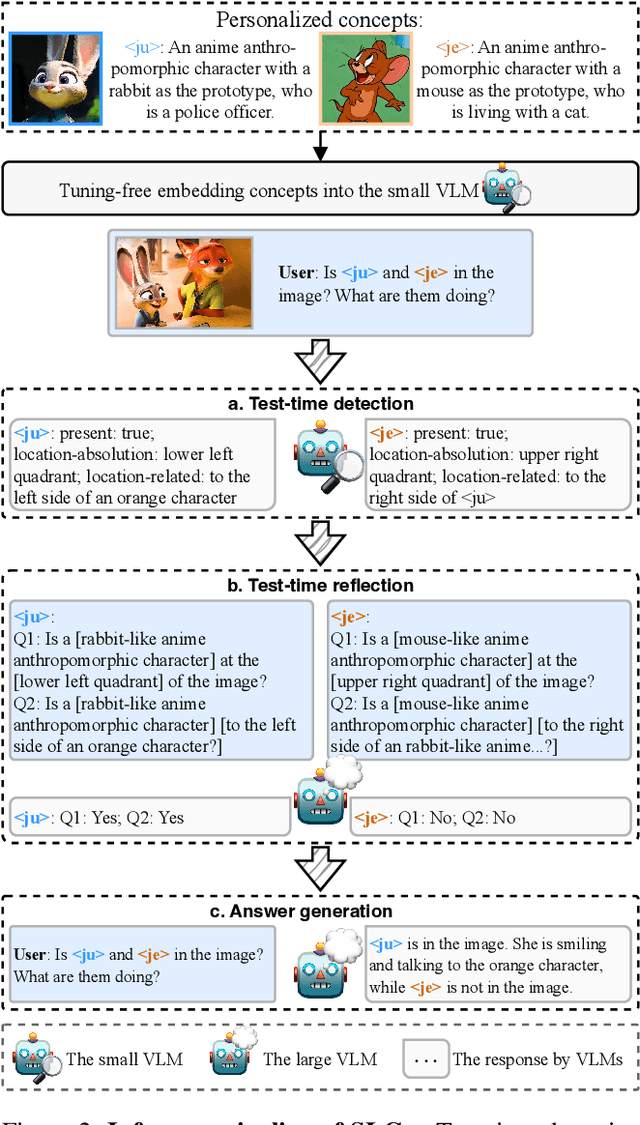
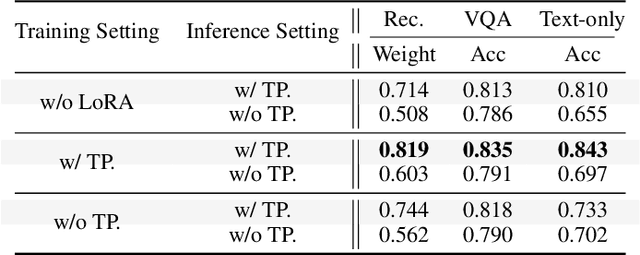
Abstract:Personalizing Vision-Language Models (VLMs) to transform them into daily assistants has emerged as a trending research direction. However, leading companies like OpenAI continue to increase model size and develop complex designs such as the chain of thought (CoT). While large VLMs are proficient in complex multi-modal understanding, their high training costs and limited access via paid APIs restrict direct personalization. Conversely, small VLMs are easily personalized and freely available, but they lack sufficient reasoning capabilities. Inspired by this, we propose a novel collaborative framework named Small-Large Collaboration (SLC) for large VLM personalization, where the small VLM is responsible for generating personalized information, while the large model integrates this personalized information to deliver accurate responses. To effectively incorporate personalized information, we develop a test-time reflection strategy, preventing the potential hallucination of the small VLM. Since SLC only needs to train a meta personalized small VLM for the large VLMs, the overall process is training-efficient. To the best of our knowledge, this is the first training-efficient framework that supports both open-source and closed-source large VLMs, enabling broader real-world personalized applications. We conduct thorough experiments across various benchmarks and large VLMs to demonstrate the effectiveness of the proposed SLC framework. The code will be released at https://github.com/Hhankyangg/SLC.
VFlowOpt: A Token Pruning Framework for LMMs with Visual Information Flow-Guided Optimization
Aug 07, 2025Abstract:Large Multimodal Models (LMMs) excel in visual-language tasks by leveraging numerous visual tokens for fine-grained visual information, but this token redundancy results in significant computational costs. Previous research aimed at reducing visual tokens during inference typically leverages importance maps derived from attention scores among vision-only tokens or vision-language tokens to prune tokens across one or multiple pruning stages. Despite this progress, pruning frameworks and strategies remain simplistic and insufficiently explored, often resulting in substantial performance degradation. In this paper, we propose VFlowOpt, a token pruning framework that introduces an importance map derivation process and a progressive pruning module with a recycling mechanism. The hyperparameters of its pruning strategy are further optimized by a visual information flow-guided method. Specifically, we compute an importance map for image tokens based on their attention-derived context relevance and patch-level information entropy. We then decide which tokens to retain or prune and aggregate the pruned ones as recycled tokens to avoid potential information loss. Finally, we apply a visual information flow-guided method that regards the last token in the LMM as the most representative signal of text-visual interactions. This method minimizes the discrepancy between token representations in LMMs with and without pruning, thereby enabling superior pruning strategies tailored to different LMMs. Experiments demonstrate that VFlowOpt can prune 90% of visual tokens while maintaining comparable performance, leading to an 89% reduction in KV-Cache memory and 3.8 times faster inference.
VersaVid-R1: A Versatile Video Understanding and Reasoning Model from Question Answering to Captioning Tasks
Jun 10, 2025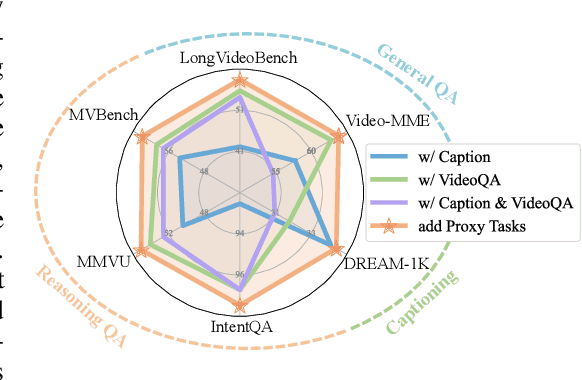

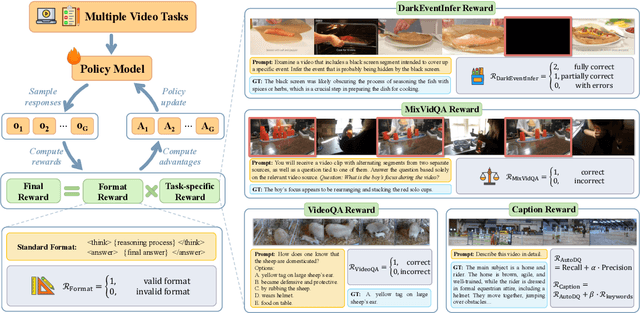

Abstract:Recent advancements in multimodal large language models have successfully extended the Reason-Then-Respond paradigm to image-based reasoning, yet video-based reasoning remains an underdeveloped frontier, primarily due to the scarcity of high-quality reasoning-oriented data and effective training methodologies. To bridge this gap, we introduce DarkEventInfer and MixVidQA, two novel datasets specifically designed to stimulate the model's advanced video understanding and reasoning abilities. DarkEventinfer presents videos with masked event segments, requiring models to infer the obscured content based on contextual video cues. MixVidQA, on the other hand, presents interleaved video sequences composed of two distinct clips, challenging models to isolate and reason about one while disregarding the other. Leveraging these carefully curated training samples together with reinforcement learning guided by diverse reward functions, we develop VersaVid-R1, the first versatile video understanding and reasoning model under the Reason-Then-Respond paradigm capable of handling multiple-choice and open-ended question answering, as well as video captioning tasks. Extensive experiments demonstrate that VersaVid-R1 significantly outperforms existing models across a broad spectrum of benchmarks, covering video general understanding, cognitive reasoning, and captioning tasks.
MMSI-Bench: A Benchmark for Multi-Image Spatial Intelligence
May 29, 2025Abstract:Spatial intelligence is essential for multimodal large language models (MLLMs) operating in the complex physical world. Existing benchmarks, however, probe only single-image relations and thus fail to assess the multi-image spatial reasoning that real-world deployments demand. We introduce MMSI-Bench, a VQA benchmark dedicated to multi-image spatial intelligence. Six 3D-vision researchers spent more than 300 hours meticulously crafting 1,000 challenging, unambiguous multiple-choice questions from over 120,000 images, each paired with carefully designed distractors and a step-by-step reasoning process. We conduct extensive experiments and thoroughly evaluate 34 open-source and proprietary MLLMs, observing a wide gap: the strongest open-source model attains roughly 30% accuracy and OpenAI's o3 reasoning model reaches 40%, while humans score 97%. These results underscore the challenging nature of MMSI-Bench and the substantial headroom for future research. Leveraging the annotated reasoning processes, we also provide an automated error analysis pipeline that diagnoses four dominant failure modes, including (1) grounding errors, (2) overlap-matching and scene-reconstruction errors, (3) situation-transformation reasoning errors, and (4) spatial-logic errors, offering valuable insights for advancing multi-image spatial intelligence. Project page: https://runsenxu.com/projects/MMSI_Bench .
RICO: Improving Accuracy and Completeness in Image Recaptioning via Visual Reconstruction
May 28, 2025Abstract:Image recaptioning is widely used to generate training datasets with enhanced quality for various multimodal tasks. Existing recaptioning methods typically rely on powerful multimodal large language models (MLLMs) to enhance textual descriptions, but often suffer from inaccuracies due to hallucinations and incompleteness caused by missing fine-grained details. To address these limitations, we propose RICO, a novel framework that refines captions through visual reconstruction. Specifically, we leverage a text-to-image model to reconstruct a caption into a reference image, and prompt an MLLM to identify discrepancies between the original and reconstructed images to refine the caption. This process is performed iteratively, further progressively promoting the generation of more faithful and comprehensive descriptions. To mitigate the additional computational cost induced by the iterative process, we introduce RICO-Flash, which learns to generate captions like RICO using DPO. Extensive experiments demonstrate that our approach significantly improves caption accuracy and completeness, outperforms most baselines by approximately 10% on both CapsBench and CompreCap. Code released at https://github.com/wangyuchi369/RICO.
MME-VideoOCR: Evaluating OCR-Based Capabilities of Multimodal LLMs in Video Scenarios
May 27, 2025Abstract:Multimodal Large Language Models (MLLMs) have achieved considerable accuracy in Optical Character Recognition (OCR) from static images. However, their efficacy in video OCR is significantly diminished due to factors such as motion blur, temporal variations, and visual effects inherent in video content. To provide clearer guidance for training practical MLLMs, we introduce the MME-VideoOCR benchmark, which encompasses a comprehensive range of video OCR application scenarios. MME-VideoOCR features 10 task categories comprising 25 individual tasks and spans 44 diverse scenarios. These tasks extend beyond text recognition to incorporate deeper comprehension and reasoning of textual content within videos. The benchmark consists of 1,464 videos with varying resolutions, aspect ratios, and durations, along with 2,000 meticulously curated, manually annotated question-answer pairs. We evaluate 18 state-of-the-art MLLMs on MME-VideoOCR, revealing that even the best-performing model (Gemini-2.5 Pro) achieves an accuracy of only 73.7%. Fine-grained analysis indicates that while existing MLLMs demonstrate strong performance on tasks where relevant texts are contained within a single or few frames, they exhibit limited capability in effectively handling tasks that demand holistic video comprehension. These limitations are especially evident in scenarios that require spatio-temporal reasoning, cross-frame information integration, or resistance to language prior bias. Our findings also highlight the importance of high-resolution visual input and sufficient temporal coverage for reliable OCR in dynamic video scenarios.
 Add to Chrome
Add to Chrome Add to Firefox
Add to Firefox Add to Edge
Add to Edge